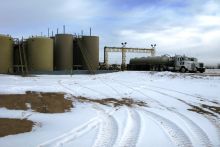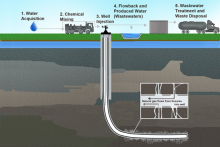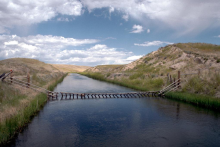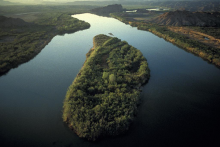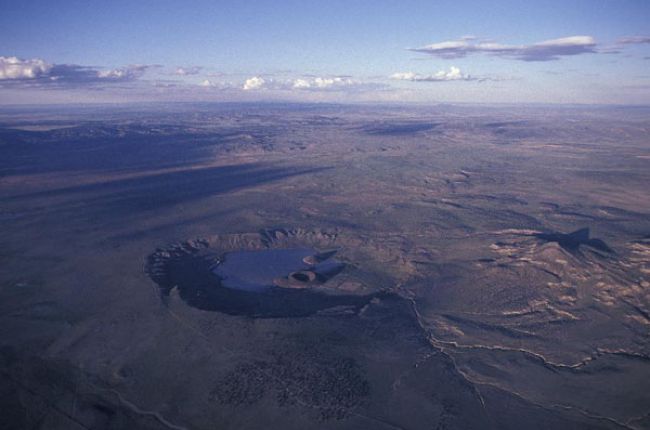
Material adapted from: Vandas, S.J., Winter, T.C., and Battaglin, W.A. 2002. Water and the Environment, p. 23,25. Published by the American Geosciences Institute Environmental Awareness Series. Click here to download the full handbook.
Groundwater occurs almost everywhere beneath the land surface. Although surface water is currently the most commonly used water source, groundwater provides about 50 percent of the drinking water in the United States. Because groundwater is our principal reserve of fresh water, it represents much of the Nation’s potential future water supply. Much groundwater is used for irrigation. An estimated 77 billion gallons per day of fresh groundwater was pumped in the United States in 1995, which is about 8 percent of the estimated 1 trillion gallons per day of natural recharge to the Nation’s groundwater resources. [In 2010, this number had fallen slightly to 76 billion gallons of fresh groundwater withdrawn per day].
Shallow domestic wells provide much of the rural population with their drinking water. In certain urban areas, deeper municipal wells supply water to many customers from a central location. Locally, the availability of groundwater varies greatly, and only a part of the groundwater in storage underground is recoverable by pumping wells. The location and movement of the Nation’s fresh groundwater resources are still being evaluated.
The availability of groundwater as a water source depends largely upon surface and subsurface geology as well as climate. The porosity and permeability of a geologic formation control its ability to hold and transmit water. Porosity is measured as a ratio of voids to the total volume of rock material and is usually described as a percentage. Unconsolidated sands and gravels make some of the most productive aquifers because they have many internal voids (porosity) that are well-connected.
If the grains of sand or gravel that make up an aquifer are all about the same size, the water-filled voids between the rock grains account for a larger portion of the volume of the aquifer than if the grains are of varied size. Therefore, an aquifer with uniform grain size usually has a higher porosity, than one with grains of varied size. Permeability is a measure of the ability of fluids to move through geologic formations. Geologic formations with a high permeability can be the best aquifers. For water to move through an aquifer, the internal voids and fractures must be connected. Geologic formations can have significant porosity and not be good aquifers if the voids are not connected, or if they are very small.
Some sedimentary rocks, such as sandstone and limestone, can also be good aquifers. Permeability in limestone is commonly provided by fractures and by openings caused by water dissolving the rock. In “karst” areas, landscapes are characterized by sinkholes, caves, and underground drainage. Most igneous rocks, such as granite, and metamorphic rocks, such as quartzite, have very low porosity and make poor aquifers unless they have interconnected fractures.
Water moves through an aquifer from areas of recharge to areas of discharge. Recharge of groundwater occurs from precipitation that infiltrates soils or that seeps from the bottom of surface water bodies such as lakes and streams. Discharge areas include streams, lakes, wetlands, coastal areas, springs, or where the groundwater flow is intercepted by wells. Water between the recharge and discharge areas is said to be in storage. Before wells are developed in an aquifer, the groundwater system is in long-term equilibrium, with recharge equal to discharge. Because the undeveloped system is in equilibrium, the quantity of water in storage is fairly constant, changing in response to annual or long-term climatic variations.
Learn More
- Ground-Water Availability in the United States (Report), U.S. Geological Survey
A comprehensive overview for a general audience on the knowns and unknowns of groundwater availability in the United States. Covers challenges in determining groundwater availability, what is known about groundwater availability in the United States, methods for regional aquifer assessment, and examples of regional aquifer assessments in the United States.
- USGS Groundwater Information Pages (Website), U.S. Geological Survey
Links to basic information on groundwater, groundwater-level data and statistics, USGS groundwater projects, groundwater data and information, technical groundwate rmodels, and USGS groundwater publications.
- Groundwater Use in the United States (Factsheet), American Geosciences Institute
Introductory factsheet on groundwater use in the United States, with basic information, key statistics, and links to more resources
- Groundwater Use in the United States (Website), U.S. Geological Survey
USGS Water Science School webpage on groundwater use in the United States since 1950.
- Managed Aquifer Recharge (Factsheet), American Geosciences Institute
Introduction to managed aquifer recharge, including how it works and its effects on water quality and availability
- Water as One Resource: How interactions between groundwater and surface water impact water availability (Webinar), American Geosciences Institute
Webinar on the links between groundwater and surface water, and implications for water management and policy.

